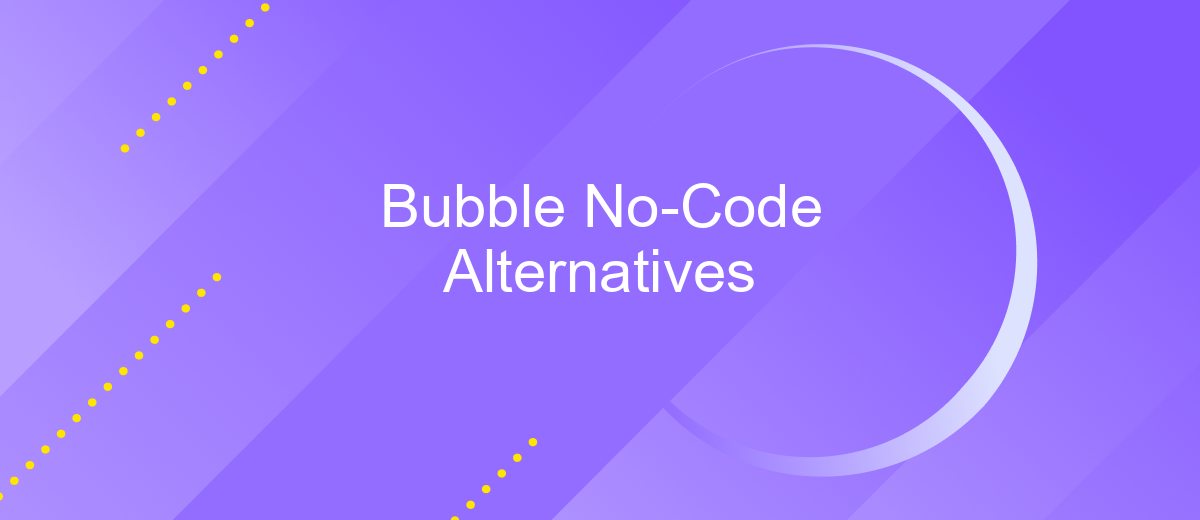Bubble No-Code Alternatives
In the rapidly evolving landscape of web development, no-code platforms like Bubble have revolutionized how we build and deploy applications. However, Bubble is not the only player in the game. This article explores various no-code alternatives to Bubble, each offering unique features and capabilities to help you create robust, scalable applications without writing a single line of code.
Introduction
Bubble has revolutionized the way we think about web development by offering a no-code platform that empowers users to create complex applications without writing a single line of code. However, it's not the only player in the market. There are several alternatives to Bubble that offer unique features and capabilities, catering to different needs and preferences.
- Webflow: Known for its robust design capabilities and CMS features.
- Adalo: Ideal for building mobile applications with ease.
- ApiX-Drive: Excellent for setting up integrations between various apps and services.
- AppGyver: Great for creating complex logic and workflows.
- OutSystems: Best for enterprise-level applications with high security and scalability.
Each of these alternatives brings something unique to the table, making it easier for individuals and businesses to find a solution that best fits their specific needs. Whether you're looking to design a stunning website, build a mobile app, or integrate multiple services seamlessly, there's a no-code platform out there for you.
Top Bubble No-Code Alternatives

When seeking alternatives to Bubble for no-code development, several options stand out for their unique features and ease of use. Adalo is an excellent choice for those looking to create mobile applications with a user-friendly interface and a range of pre-built components. Webflow is another powerful tool, particularly for web designers who want to build responsive websites without diving into code. It offers a robust CMS and extensive design capabilities, making it ideal for creating visually stunning sites.
For those who need to integrate various services and automate workflows, ApiX-Drive is a noteworthy alternative. This platform simplifies the process of connecting different applications and automating data transfers, enhancing productivity without the need for coding skills. Glide is also worth mentioning, especially for converting Google Sheets into mobile apps quickly. It’s perfect for users who want to leverage their existing data in a dynamic, app-based format. Each of these alternatives provides unique strengths, making them viable options depending on your specific project needs.
Comparison of Features and Pricing

When evaluating Bubble No-Code alternatives, it's crucial to compare both features and pricing to determine the best fit for your needs. Various platforms offer unique capabilities that can streamline your development process without requiring extensive coding knowledge.
- Webflow: Renowned for its powerful design tools, Webflow allows for intricate design customization and offers a free plan with limited features. Paid plans start at /month.
- Adalo: Adalo is user-friendly and ideal for building mobile apps. It offers a free plan with basic features, with paid plans beginning at /month.
- ApiX-Drive: For those needing seamless integrations, ApiX-Drive excels in connecting various applications and automating workflows. Pricing starts at /month.
- OutSystems: Known for its robust enterprise solutions, OutSystems offers advanced features suitable for large-scale applications. Pricing is available upon request.
Each platform provides a distinct set of features catering to different project requirements and budgets. For instance, ApiX-Drive is particularly beneficial for businesses that need to automate and integrate multiple services effortlessly. Carefully assessing these aspects will help you choose the most suitable no-code platform for your project.
Choosing the Right Alternative for Your Needs

When selecting the right Bubble no-code alternative for your needs, it's essential to consider your specific requirements and the features each platform offers. Each tool has its strengths and weaknesses, so understanding what you need will help you make an informed decision.
First, evaluate the complexity of the projects you plan to build. Some platforms are better suited for simple applications, while others excel in handling more complex workflows and integrations. Additionally, consider the ease of use and learning curve associated with each tool.
- Feature Set: Ensure the platform offers the essential features you need.
- Scalability: Check if the tool can grow with your business.
- Integration Capabilities: Look for platforms that support integrations with other services, such as ApiX-Drive, to streamline your workflows.
- Cost: Compare pricing plans to find one that fits your budget.
- Community and Support: A strong community and reliable support can be invaluable.
Ultimately, the best no-code alternative for you will depend on your unique needs and goals. Take the time to research and test different platforms to find the one that aligns with your vision and provides the functionality you require.


Conclusion
In conclusion, exploring Bubble no-code alternatives opens up a myriad of opportunities for businesses and individuals aiming to build robust applications without extensive coding knowledge. These platforms offer diverse features, from drag-and-drop interfaces to advanced customization options, catering to various project needs and skill levels. By leveraging these tools, users can accelerate development timelines, reduce costs, and bring their ideas to life more efficiently.
Moreover, the integration capabilities of these no-code platforms are crucial for creating seamless workflows and enhancing functionality. Services like ApiX-Drive facilitate easy integration with multiple applications, ensuring that your no-code solution can interact smoothly with other tools and services you rely on. As the no-code movement continues to evolve, these alternatives to Bubble will play a significant role in democratizing software development and empowering a wider range of creators.
FAQ
What are some popular no-code alternatives to Bubble?
Can I integrate APIs with no-code platforms other than Bubble?
Are no-code platforms suitable for building complex applications?
How do no-code platforms handle data security?
Can I migrate my project from Bubble to another no-code platform easily?
Time is the most valuable resource in today's business realities. By eliminating the routine from work processes, you will get more opportunities to implement the most daring plans and ideas. Choose – you can continue to waste time, money and nerves on inefficient solutions, or you can use ApiX-Drive, automating work processes and achieving results with minimal investment of money, effort and human resources.

